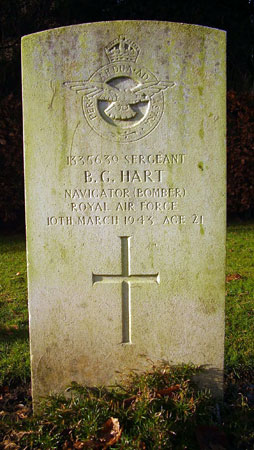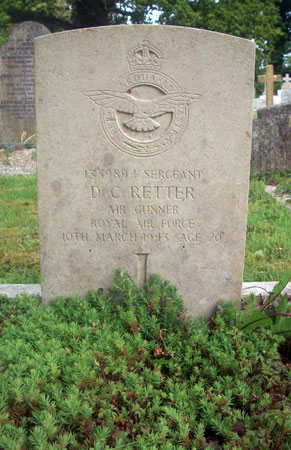Halifax W1039 near Seaton Ross.
On 10th March 1943 this 10 Squadron aircraft had just taken off from Melbourne airfield so it could be ferried to another airfield. Soon after leaving the ground the port outer engine was either deliberately shut down or had failed and the propeller was feathered. The aircraft was seen to begin flying a left hand (anti-clockwise) circuit of the Pocklington area presumably to go in to make a landing at Melbourne but in making a left hand (port) turn to get into the circuit the aircraft's port wing dropped, the aircraft then stalled from 300 feet and dived into the ground around a mile west of Seaton Ross at 19.10hrs. This cause of a crash was a common problem when pilots turned the aircraft into the side with a failed engine, the aircraft did not have enough power on the side with a dead engine to keep it flying and when the wing then dropped, the aircraft was pulled towards the ground.
Pilot - Sgt Geoffrey Francis Peck RAFVR (1332790), aged 21, of Isleworth. Buried Twickenham Cemetery, Middlesex.
Flight Engineer - Sgt Archie Allen Muirhead RCAF (R/89110), aged 24, of Toronto, Ontario, Canada. Buried Reay New Cemetery, Caithness.
Navigator / Bomber - Sgt William Browning RAF (657584), aged 31. Buried Barmby on the Moor Churchyard, Yorkshire.
Navigator / Bomber - Sgt Basil Graham Hart RAFVR (1335639), aged 21, of Oxshott, Surrey. Buried Barmby on the Moor Churchyard, Yorkshire.
Wireless Operator / Air Gunner - Sgt Alfred Norman Boreham RAFVR (1366071), aged 32, of Portobello, Edinburgh. Cremated warriston, Edinburgh.
Air Gunner - Sgt Denis Cyril Retter RAFVR (1339894), aged 20, of Whimple. Buried Whimple New Churchyard, Devon.
Sgt Hart's and Sgt Browning's gravestones at Barmby Moor. William Browning attended Brighton Grammar School as a boy but his family details are not listed on the CWGC website.
Alfred Boreham's photograph was found on "www.findagrave.com" to whom I credit this photograph.
Denis Retter's grave in Whimple Churchyard, Devon. I credit Mr Rob Pearson with this photograph.
Halifax W1039 was built to contract B.982938/39 by English Electric Co.Ltd. at Samlesbury and was awaiting collection on 8th March 1942. It was by 10 Squadron at Leeming on 15th March 1942 where it was coded "ZA-C". On 28th April 1942 it received minor damage to the aileron controls and starbord flap controls while on an operational flight to attack the Tirpitz in Faettenfjord, Norway whilst operating out of Lossiemouth. It sustained Cat.Ac/FB damage and was repaired on site, being returned to service the same day. The next day it was again being used on Ops to attack Tirpitz and it again received flak damage to the fuel cocks that resulted in the starboard engine to fail. An eighteen inch hole in the tailplane and a twelve inch hole under navigator's position were also created by flak but the crew limped back across the North Sea. Cat.Ac/FB damage was again the damage assessment and it was repaired on site. On 19th August 1942 10 Squadron moved to Melbourne but by this date the aircraft appears to be a spare aircraft. It returned to operational use in September 1942 and was coded "ZA-O". By March 1943 it was not required by 10 Squadron and was replaced as "ZA-O" by Halifax DT792. As a result of the crash on 10th March 1943 Cat.E2/FA Burnt damage was the damage assessment and it was struck off charge on 21st March 1943.




Archie Muirhead was born on 16th August 1918 in Toronto, Ontario, Canada and was the son of James Wesley and Jessie Simpson (nee Murray) Muirhead. His parents were probably both of Scottish descent; his mother was certainly born in Scotland and his father's father possibly. After leaving school in 1935 he briefly worked at a paint company before starting work as an operator for Canada Wire and Cable. In 1940 he left this job to study at the Galt Aircraft School. He enlisted for RCAF service in Galt, Ontario on 14th February 1941 and initially enlisted for ground duties, specifically as an airframe mechanic. After undertaking basic training in Canada he left for service in the UK, arriving in February 1942 and serving at 406 Squadron as a member of ground crew. With the need for flight engineers to serve in four-engined bombers he then re-mustered to aircrew as a flight engineer in September 1942, he trained at No.4 School of Technical Training and 1658 Heavy Conversion Unit before posting to 10 Squadron on 21st February 1943. He is buried near Thurso, on the north coast of Scotland which was probably where his father's family lived prior to emigrating.